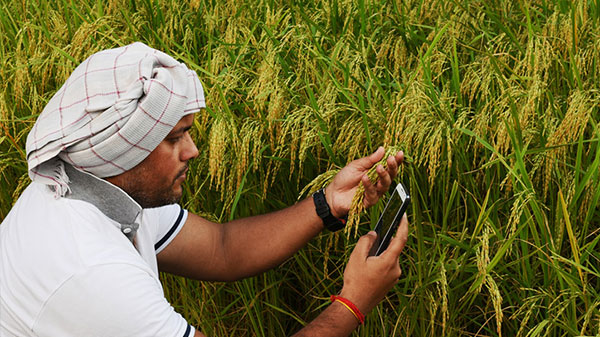Agricultural & Environmental Concerns: Role of Education

Yesterday, I spoke at a seminar on the subject theme organised by Knowledge Xchange in Chennai. This is a summary of what I said…
You must’ve heard several speakers on the subject since morning, and now you must be wondering what a corporate has to do with this topic. Let me deal with that first.
Purpose of education = Know How. Know How has two components. Firstly, Know What. Training typically focuses on Know What, while education is expected to build the other component of the capacity i.e. Know Why.
Purpose of Know How = Do How.
And, purpose of Do How is to actually “do” things that “deliver” the intended outcomes.
What are those outcomes, in relation to the Seminar theme?
- Raise incomes for the farmers (Per Capita GDP of Indian farmers is just about a third of the rest of Indians)
- Achieve Food & Nutrition Security for our all our people (a third of all our children are malnourished)
- Do this in an environmentally sensitive manner (so that we leave a habitable world behind for our children and their children)
The theme of my talk is “What can Corporates do, to enable these outcomes?”
Basically, I have three messages to share:
- For the Know How to be effective, the medium (of education) must be tailored to the context.
- For the Know How to be translated to Do How, the education must be an integral part of a “meta-process”
- To execute the idea of a meta-process in the real world on a large scale, you must leverage the power of innovative business models
To substantiate these arguments, I will walk you through the nature of challenges in Indian agriculture and the corresponding solution themes. And then illustrate those through the creative solutions successfully deployed by ITC on the ground.
- The context of Indian agriculture and the farmer is quite complex, with multiple dimensions and each dimension with multiple degrees of challenges. The “media strategy” of “education”, if I may call that, must be tailored to this context. Let me outline four of those dimensions, relevant to our theme today.
- Any context must first be seen from the perspective of “outcome for the consumer”, in our case the “farmer”. Each of our famer is so very different from the other. Starting with variations in farm size, to the heterogeneity in agro-climatic conditions, to the far more individualised resource availability and risk taking ability. In other words, one message is not relevant to all farmers. That means, many messages need to be personalised, some can be mass-customised, while a few can be generic.
- The second dimension of the context, is the “nature of message” itself. That varies according to the action that the message should trigger to achieve the objective. In some cases, it could be simple awareness about a market or a weather condition; while in another case, it may need to alter an existing farm practice such as seed rate or row spacing; in yet another case, it could create a conflict between short term effort or cost with long term benefit (such as investment in micro irrigation for soil conservation). Again, obviously, one tool doesn’t trigger action in all cases. In one case it could be SMS on mobile phone, in the other it is an on-farm demo, and may be an audio-visual in another case.
- The third dimension is “time” that enables action. In agriculture, as you will all know, most activities are very time sensitive. Therefore, a piece of information or a knowledge component has to be delivered absolutely on time. Especially when some of the actions are linked to random events like rain fall or pest attack.
- The last dimension is “cost”. Notwithstanding different levels of message and types of tools, obviously the cost can’t be out of whack with the benefit being delivered or the risk being managed.
In ITC eChoupal, multiple media are used in a 3600 approach tailored to the need. For example, improved practice or a new input through the eChoupal website, followed by an on-farm demonstration through Choupal Pradarshan Khet for better conviction; then the adoption is facilitated through SMS reminders & telecalling to clarify suitability for specific farm condition, and obtaining feedback on practice / product performance through tele-helpline.
- The second message is about translating all this Know How to Do How. The farmer may know what to do, but many times timely & affordable access to other inputs is a problem. Be it, credit or seed or some crop protection chemical. In the mind of the farmer, all of these elements are part of one process. Call it the “meta-process”, because it is in the mind of the farmer. Deciding which crop to grow, managing it through the crop season, and then realising cash from the crop. But, these needs are served by different industry verticals such as agri extension, banks, seed companies and so on… Unlike in evolved markets, the delivery of these inputs is not synchronised with knowledge. Therefore, the action doesn’t happen often. Consider an evolved market like buying a car in Chennai. You can acquire the knowledge about a car suitable to your needs through several magazines, a loan through a bank, actual vehicle from a dealer, insurance from an agent, and the service arrangement through a dealer seamlessly. But, for many farmers in rural India, such seamless process is still a dream. Fragmented farm sizes, dispersed villages, heterogeneous conditions compounded by weak infrastructure make synchronised delivery a challenge.
ITC eChoupal factors these challenges while orchestrating an ecosystem that delivers the desired end-to-end solution to farmers. It is achieved through a new digital, physical and human infrastructure organised in a hub & spoke configuration. Today some four million farmers access services through the ITC eChoupal network, offered by 160 organisations cutting across Government, Private and Social Sectors.
- To roll out an infrastructure like eChoupal on ground, it costs a lot of money. How ITC designed a business model so that the cost of such a system is not a burden on the farmer, but recovered through innovative revenue models, is the third message.
For example, by eliminating non value adding costs of a village to mandi to our warehouse chain through a village to our warehouse chain by discovering price in the village is one such model.
In another model, we embed traceability along the chain (having sourced directly from the farmers) into our products, we deliver greater value to consumers and capture some of that value for ourselves and the farmers.
Yet another model is charging a toll on these 160 organisations for bringing them cost-effective access to the rural markets.
Allow me to repeat my three messages, before I close:
- For the Know How to be effective, the medium (of education) must be tailored to the context.
- For the Know How to be translated to Do How, the education must be an integral part of a “meta-process”
- To execute the idea of a meta-process in the real world on a large scale, you must leverage the power of innovative business models
Thank you.










